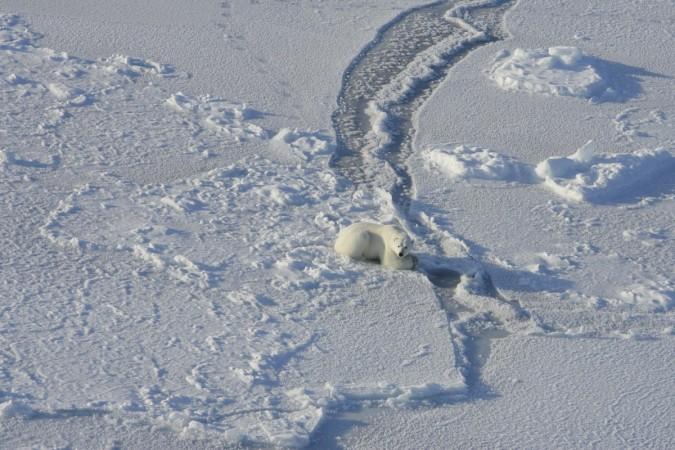
Polar bears, the apex predators of the Arctic, need more fat-reach food than previously thought, but melting sea ice in the region makes it difficult for them to meet their energy needs, a new research has revealed.
After monitoring nine free-ranging female polar bears over two years, the researchers found that their high energy demands required consumption of high-fat prey, such as seals, that are easy for the animal to catch on sea ice. But, since the seals are hard to come by in ice-free conditions and the sea ice continues to melt more than ever, polar bears are suffering from "an energy deficit."
As part of the study, published in the journal Science on Friday, the researchers monitored the behaviour, hunting success and metabolic rates of the adult female polar bears without cubs as they hunted for prey on the sea ice of the Beaufort Sea in the spring.
The researchers used high-tech collars on the bears to record video, locations and activity levels over a period of eight to 11 days. They also used metabolic tracers that helped them determine how much energy the bears were expending.
"We've been documenting declines in polar bear survival rates, body condition, and population numbers over the past decade," the study's first author Anthony Pagano, a Ph.D. candidate at the University of California, Santa Cruz, said in a statement. "This study identifies the mechanisms that are driving those declines by looking at the actual energy needs of polar bears and how often they're able to catch seals."

In an average, the metabolic rates of the monitored polar bears were over 50 percent higher than previously predicted by other studies. In addition, five of the nine bears in the study lost their body mass, suggesting that they were unable to catch enough fat-rich mammal prey to meet their energy demands.
What makes it even more alarming is the fact that the bears were struggling to find food at the start of the period from April through July when these animals catch most of their prey and put on most of the body fat that help them sustain throughout the year.
As climate change continues to have dramatic effects on the Arctic sea ice, polar bears are forced to cover greater distances, making it harder for them to catch prey.
In the Beaufort Sea, for example, the polar bears are forced to move much greater distances than they previously did as the Arctic warms and more sea ice melts. The bears, therefore, are ending up burning more energy during the summer as they are fasting until the ice returns in the fall.
In other areas like Hudson Bay, the sea ice is breaking up earlier in the summer and returning later in the fall, which has forced the polar bears to spend more time on land.
According to recent measurements, the extent of Arctic sea ice is decreasing at a rate of about 14 percent in every 10 years, which can significantly reduce polar bears' access to seals.
Meanwhile, the most recent polar bear population estimate by USGS also indicated nearly 40 percent decline over the past decade.
"We now have the technology to learn how they are moving on the ice, their activity patterns, and their energy needs, so we can better understand the implications of these changes we are seeing in the sea ice," Pagano said.









!['Had denied Housefull franchise as they wanted me to wear a bikini': Tia Bajpai on turning down bold scripts [Exclusive]](https://data1.ibtimes.co.in/en/full/806605/had-denied-housefull-franchise-they-wanted-me-wear-bikini-tia-bajpai-turning-down-bold.png?w=220&h=138)



